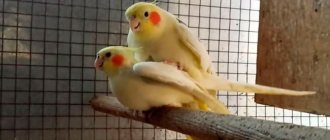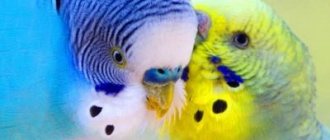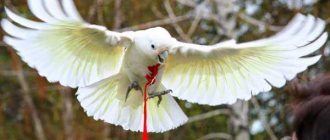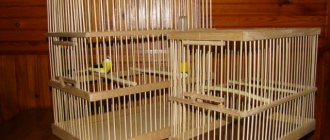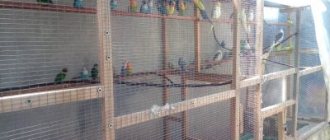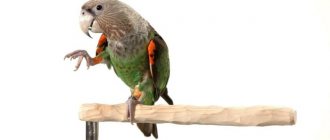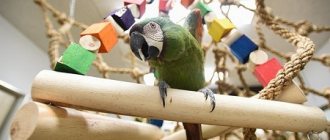Birds need nests to reproduce. In their wild habitat, the birds make the necessary structures for themselves. They can easily find all the materials needed for construction in nature. As for poultry, they cannot do without a caring owner. Therefore, in this article we will tell you how to make a nest or house for lovebirds with your own hands.
Pair selection
When selecting a pair, you need to make sure that the male and female are not close relatives. This is undesirable and can only be used as a special measure to strengthen certain traits in the offspring or when creating a new variety. An important point is the sympathy of individuals; it is worth paying attention to already created pairs in the flock, and with the help of them to breed offspring. Sometimes parrots exhibit antipathy towards each other. It happens that artificially created couples may not have offspring for years, even under the best conditions.
Lovebirds choose a mate for life. A couple does not always form easily and quickly. Sometimes quarrels between the female and the male are observed, which indicates careful selection. When a pair is created, if the birds are healthy and active, the male constantly courts the female and mating occurs quickly.
What should a nesting house be like?
Nesting structures resemble ordinary birdhouses in appearance. This house is the initiative of the bird owners. If you want to please the birds to the fullest, they should build a nest box. Such a “natural” nest is more difficult to make, since it is necessary to find a suitable piece of tree trunk and then carefully hollow out the core from it. Thus, you will get an artificially created hollow.
In nature, lovebirds seek shelter in tall trees to protect their offspring from insidious predators. In hollows the birds are warm and the female is calm. The principles for making nest boxes and box houses are different, but the internal dimensions and environmental requirements are the same. It’s easier to put together a box-type wooden house of suitable dimensions. If you maintain the correct proportions and choose good material, this design will be an excellent alternative to a nest box.
Preparing for nesting
The preparatory period takes approximately 2 weeks. All changes should occur gradually so that the birds do not experience stress.
1. The most successful time for reproduction is at the end of spring and beginning of autumn. 2. If the weather is warm, then you can put the cage in the sun for 30-40 minutes. Sunbathing speeds up metabolism, strengthens muscles, and improves appetite. This has a good effect on egg fertility. 3. It is useful to let birds fly around the room for several hours.
4. The cage must be large so that the birds can fly in it. It’s good if the cage has 2-3 doors. 5. The room temperature must be at least 18 degrees. 6. It is necessary to introduce sprouted grains, eggs, and cottage cheese into the diet. You can sprout oats and millet, give one teaspoon a day for two. 7. Increase the length of your day by 15-20 minutes every day. You can use a lamp for this. 8. After 14 days, the length of the day should be between 14-16 hours. 9. Increase in soft food. In the first week, 1 teaspoon every other day. Then every day, a spoon for two, at the last stage, a spoon for each.
10. According to the addition of other food, the amount of grain decreases. 11. Fruits and greens may not be limited.
After 2 weeks, the behavior of the birds changes noticeably. They are very active, sing quite loudly, and look for secluded corners in the cage. After this, the birds are given a nest box. For lovebirds, nest arrangement is very important. Nest boxes are an unconditional irritant for them and stimulate them to create offspring. If the nest is removed during the breeding process, this may delay the maturation of the eggs. It can also lead to ovarian dysfunction in females. Knowing this feature of parrots, you can regulate their reproduction by placing or removing a nest box at the right time.
How to create the necessary conditions in winter
If birds decide to lay eggs in the cold season, you need to think about creating all the necessary conditions. A humidifier must be running in the room where parrots are kept. Required air humidity is 60%. Temperature conditions are also important for breeding lovebirds and producing healthy offspring at home. The air is not heated above +20 °C, and the temperature is not allowed to drop below +18 °C.
Additional lamps are placed in the rooms, daylight is extended to 15 hours a day. Heating lamps with a power of no more than 60 W are placed next to the cage.
How to make a nest for lovebirds with your own hands
For breeding chicks, nest boxes or nest boxes can be used. They are vertical and horizontal. The nesting device is suspended at a distance of at least 30 cm from the corner and 20 cm below the top mesh. You can buy a nest for lovebirds; now there is a very large selection. You can make a nest for lovebirds with your own hands.
Nest sizes for lovebirds. To make a nest box, you need dry boards from 2 to 3 cm thick. The bottom should be approximately 17 cm in length and width, 25 cm in height. If the area is smaller, the chicks will be cramped, and some of them may be crushed. The entrance is made at a distance of 3 cm from the lid, measuring approximately 5 cm. The roof is made pitched. All parts are secured with screws or nails. When choosing the size of a nest for lovebirds, the main thing is to take into account that the bird can freely enter the nesting box and fit there with the chicks. The wood inside the lovebird nest should be rough to make it easier for the parrot to get out. It is best to attach a wooden strip as a step. You can attach a piece of metal mesh.
Dimensions of a horizontal nest for lovebirds: length 25 cm, width 15 cm, height maximum 15 cm. The entrance is located at a distance of 3 cm from the top and from the edge, its diameter is 4.5 cm. In this case, the nest will be located at the opposite end. The positive point is that such a nest for lovebirds provides greater safety: the bird cannot damage the clutch or chicks upon entering. It is also more spacious. Both the female and the growing chicks can emerge from the horizontal nest. The disadvantage of horizontal nesting is that even small chicks may fall out of it.
Sometimes a combination is observed. The size of the nest for lovebirds in this case is 15 cm wide, 22 cm long, and 20 cm high. The remaining parts are made in the same way. This reduces the risk of damage to the chicks. However, this type of lovebird nest is too large, so it may be difficult for the parrot to get out of it. If the bottom is made of thick wood, then you need to make a small depression inside, 10-12 cm in diameter, so that the eggs do not roll out. If the tree is thin, then you need to make a special bowl separately and then put it inside.
The nest is made from a section of a trunk, from which the core is removed. The dimensions of the nest for lovebirds are kept to standard sizes. The lid and bottom are attached at the top and bottom. A nest box is most often used, since ventilation is poorer in a nest box. In addition, making a nest box is more difficult.
Any type of nesting box must have a hinged or removable lid so that it can be inspected, cleaned, and disinfected. Before hanging, it must be disinfected by scalding with boiling water and a disinfectant. Then it must be thoroughly rinsed with water and dried.
Material
It is important to choose high-quality environmentally friendly material. Store structures are sometimes made of particle board. In such a nest, the chicks and the female will breathe fumes from the harmful adhesive composition with which the shavings are impregnated. Therefore, experienced breeders do not recommend using chipboard for lovebirds. An exception may be fragments of laminated chipboard from old furniture. A thick coating over pressed, glued sawdust protects against fumes.
The best materials are plywood or wooden boards. Suitable from fruit boxes or birch picket fence. Wooden boards of any quality must first be dried and sanded. This way, possible burrs are removed and the workpieces are given a neat appearance.
Building a nest for lovebirds
Lovebirds build their nests from fresh wooden twigs. Branches of fruit trees, birch, linden, and willow are suitable. The diameter of the branches is approximately 0.5 cm, length 8-10 cm. In the process of domestication of parrots, some of them lost the skill of building nests. They can carry all the branches into the nest box so that it is filled to the very top. There will be no room for them to hatch their eggs. Other birds lay down too few twigs.
To avoid such situations, select the required number of branches so that you can fill the nesting box with them up to the entrance. Then select the thinnest of them, place them on the bottom 3-4 cm high. Place the remaining branches in the cage. Even if lovebirds do not want to build a nest, these branches will be enough to hatch eggs. If the parrot builds the nest itself, it will be ready in about 15-20 days.
During the same period, you need to exclude greens from your diet and limit your consumption of fruits. As soon as the female has laid the first egg, soft food is excluded. It is necessary to leave only the grain mixture and sprouted grain.
Age of feathered parents
This indicator is very important for breeding a pair of lovebirds without the help of an ornithologist at home. If the birds' plumage is faded and there is a clearly defined black spot near the beak, they are no more than 2 months old.
The first molt begins at 4–6 months from the frontal part of the head. The next period will begin in a year, after which it is almost impossible to determine the age of the bird.
At 9 months, the reproductive system of lovebirds is fully formed, but they are not yet ready to reproduce. The barely grown chicks themselves will not yet be able to properly care for their offspring. Young parents and their brood are more likely to become ill, leading to mortality.
When lovebirds are one year old, they are completely ready to breed. Up to 4 years old birds retain the ability to give birth to healthy offspring.
Hatching chicks
Typically, the female lays 5 eggs. It is advisable not to disturb the birds during this period; you need to clean the cage very carefully. At first, the female may leave the nest frequently, but later this becomes much less common. Not all chicks hatch; some lack moisture or oxygen and die. The cause of death may be too high a temperature when hatching in the summer. To avoid this, you can make holes in the bottom of the nesting box and spray the nesting with water. The parrot warms the eggs with its body. The female turns them over and moves them twice a day. This is done in order to heat evenly.
After about a week, it will be possible to determine which eggs are fertilized. As a rule, they are matte and have a gray-white color. If you look at the light, you will see a thin web of blood vessels. Unfertilized eggs may be yellow, spotted, or shiny. They can be removed from the lovebird nest only if the clutch is large. If it is small, then they should be left. They only protect the hatched chicks from harm.
Sometimes during the first nesting it happens that all the eggs are unfertilized. In this case, they do not need to be removed from the nest. It is necessary to allow the bird to sit for the entire period, since the breeding rhythm may be disrupted. After this, the bird will begin a second clutch. You can replace several unfertilized eggs from other nests if you have several pairs of lovebirds.
It very rarely happens that a bird eats its own eggs. Then you need to make a double bottom in the nesting area. You need to make a hole in one of them so that the laid eggs fall down. The main thing is to make a soft bedding from hay, sawdust, and cotton wool. Then these eggs can be placed on another female to hatch.
Birds from the same brood or family
A pair of birds must be purchased from different nurseries or from different breeders. Parrots that are close in blood cannot become parents of full-fledged offspring. This can lead to various complications:
- empty, unfertilized eggs;
- small masonry;
- poor survival of offspring;
- external defects in chicks.
On a note. Close relationships are used for breeding birds and obtaining new shades of plumage. This method is not suitable for crossing lovebirds at home.
Pokemon GO: how to hatch eggs and what's probably inside
(Image: Pokemon GO)
If you've just started playing Pokemon GO, you've probably already picked up an egg or two.
Pokemon GO Identification Chart: List of ALL 151 Pokemon in the Game
They can be found floating next to Pokeballs at PokeStops, but like many things in Pokemon GO, it's not entirely clear what you're supposed to do with them.
But, as players will quickly learn, they are very important if you want to completely fill out your Pokédex and maximize your progress.
How to hatch an egg
To hatch an egg, you first need to place it in the incubator. Do this by first clicking on your red and white Pokeball and pressing the Pokemon button. Then select "eggs" in the top right corner of the screen.
Touch one of the eggs and a menu with your incubators will appear. If you just started playing the game, you should have one incubator with infinite uses. For those who have been playing a little longer, you may have even purchased a second incubator with a certain number of uses. Click on one of the incubators and select "start incubation".
The egg will hatch if you walk the distance indicated on the egg - usually 2, 5 or 10 kilometers.
You can also get "lucky" eggs.
If you want more incubators and can't wait, you can buy more with coins.
Don't try to cheat by using a car, bus or train
The eggs do not register speed if it exceeds 20 miles per hour.
What happens when the egg hatches
As you might have guessed, eggs hatch into different types of Pokemon. But you may not have realized that Stardust and Experience Points also hatch. As you progress through the game, this becomes more and more important as you try to evolve and strengthen your Pokemon.
Eggs will quickly become your main source of Stardust, especially for higher level Pokémon that require more Stardust to power up.
Happy eggs
They are different from the 2, 5 or 10 km long eggs and give experience points (XP) when active and you can buy them with coins.
MORE: Man Quit His Job to Hunt Monsters Full Time in Pokemon Go
MORE: Pokemon GO: These Pokemon Are Just the Fucking Worst
Reviews about
Lifespan
Lovebirds are one of the most common and popular parrots among small and medium-sized breeds. Birds live both in the wild and at home. It is known that small parrots live shorter than their larger counterparts.
At home
There are interesting cases where pairs of lovebirds lived in captivity for about 20 years. This is quite possible with proper care and good health of lovebirds. Still, the average lifespan of a parrot at home is 10 years. Several factors can lead to premature death.
Various diseases. Ornithologists claim that birds are susceptible to many diseases. If you buy a lovebird secondhand and it looks healthy outwardly, this is not a guarantee. The disease may appear after the end of the incubation period.
Inattention to the health of the parrot. At the first signs of illness, you should urgently take the bird to the veterinarian to double-check everything and, if necessary, treat it. If there is only one parrot in a pair that behaves atypically, be sure to separate them, which will protect the lovebird’s partner from infection.
Poisoning. If you do not change your parrot's food and water for a long time, then mold and mildew begin to develop there. As a result of eating spoiled food, a parrot can become seriously poisoned. Remember, lovebirds love to chew on things. The cause of poisoning can even be paint that the parrot has chipped with its beak from the bars of the cage.
Poor nutrition. Lovebirds can eat any food, but their diet still needs to be closely monitored. Often a bird eats something that is harmful to its health.
Dangerous household appliances within the parrot's reach. If you let a bird out of its cage, it will fly everywhere and chew everything. Thus, lovebirds can chew through a live wire or drown in an open pot of soup.
Birds need time to adapt to the environment in which they find themselves. The lovebird needs to get used to the arrangement of objects in your home. If you move something large, be sure to show it to the bird
A parrot may inadvertently fly into an unfamiliar obstacle and crash.
Open windows pose a great danger to a parrot. Even a tamed and obedient bird can fly out or fall out due to carelessness
This almost always leads to death, since the domestic lovebird cannot adapt to life in the wild.
Fear. Lovebirds, like most parrots, are very shy. Intense experiences (anxiety, fear) can lead to sudden cardiac arrest. In this case, it is impossible to save the lovebird.
Other pets. Even if the cat and dog do not eat parrots, this does not mean that they do not pose a threat. Even in a friendly game, a large animal can hit a lovebird with its paw. The parrot's body is quite fragile, it can die as a result of injury.
In nature
Untamed lovebirds live much shorter lives than their domesticated relatives. They rarely reach 10 years of age. Natural habitat is tropical Africa and Madagascar. The hot and humid climate in this area provides a variety of food and sufficient drinking water for lovebirds.
Wildlife carries many dangers and risks for small birds, which leads to a shortening of the average lifespan. The causes of early death may be the following:
- during periods of drought, it is difficult for small lovebirds to fly long distances to search for water; to reduce the population, some farmers poison the water, even if the bird finds something to drink, it is not a fact that it will not die from it;
- birds often plunder farmers' fields, so people destroy them as pests;
- Quite brutal fights for territory occur within the species flock, as a result of which injured individuals die;
- attacks by predators - vultures, owls, eagle owls and other large birds hunt lovebirds both day and night.
How many steps does it take to hatch a Larvesta egg?
Pokemon Database
- Data Pokemon Data Pokédex
- moves
- Type table
- Capabilities
- PC.
- Evolution chains
- Pokemon locations
- Sprite gallery
- Links
- National Pokédex
- List of Pokemon with statistics
- Pokédex of Ultra Sun and Ultra Moon
- Let's go, Pikachu / Eevee Pokédex
- Pokédex Sword & Shield
- Breeding and egg groups
- Sword and shield
- Questions and answers about Pokemon
PokéBase - Questions and answers about Pokemon
Meta Rate my team
- Login
- register
- All actions
- Questions
- No answer
- Tags
- Users
- Ask a question
- Rules
- Chat
1 vote
Must.
… I know …..
- eggs
- Luke
Lifespan
The bird is quite unpretentious in care: it eats store-bought food with pleasure, with proper care it rarely gets sick, and does not require special housing conditions.
Small species of parrots live on average from 10 to 15 years, lovebirds are no exception. Very rarely this species can live up to 20 years. This happens in conditions as close as possible to its natural habitat, where they live for 20 years or more. Without a partner, a parrot can live about 10 years with proper care
An isolated individual needs attention and communication. A lonely lovebird parrot will live at home, but how long depends on the care
A parrot can die for several reasons:
Lack of medical care. Lack of consultation from a content specialist. Inattention of the owner, including when the bird was able to fly out of an open window. Electricity. Birds often die from chewing wires. Ignoring the primary symptoms of the disease. Poisoning with toxic substances. A bird can crash in flight against interior items.. https://www.youtube.com/embed/MEXm0W6TdH0
The reasons for the death of parrots in captivity show that ignoring the rules for keeping a domestic bird and neglecting its condition threatens with irreparable consequences. Under the same roof as a person, lovebirds live for quite a long time, it all depends on how much attention the owner pays to them.
Following the maintenance recommendations will significantly extend the life of this bird. With proper care, a pet has bright shiny feathers, good health and appetite, and brings joy to its owner every day for many years. How many years parrots, in particular lovebirds, live at home depends only on the owner.
Diet
When preparing birds for mating, their diet is saturated with protein foods: cottage cheese, eggs, insects. It is good to feed your pets cereals: rice, oatmeal, pea. You can add sprouted seeds, honey (2 g), lemon juice (no more than 2 drops per day).
In summer, the birds’ diet does not change; they have plenty of natural vitamins from seasonal vegetables and fruits. In winter, special complex supplements are introduced for parrots. Pet food is enriched with phosphorus and calcium. These elements are found in abundance in bone meal, eggshells, and nuts.
